Strategic Management for JD Sports-fashion's Expansion in India
VerifiedAdded on 2023/06/17
|15
|4894
|356
AI Summary
The report analyses the strategic management approach for JD Sports-fashion's expansion in India. It includes PESTLE analysis, Porter's Five Forces analysis, and VRIO analysis to identify the internal and external factors affecting the company's expansion. The report suggests differentiation strategy for the expansion.
Contribute Materials
Your contribution can guide someone’s learning journey. Share your
documents today.
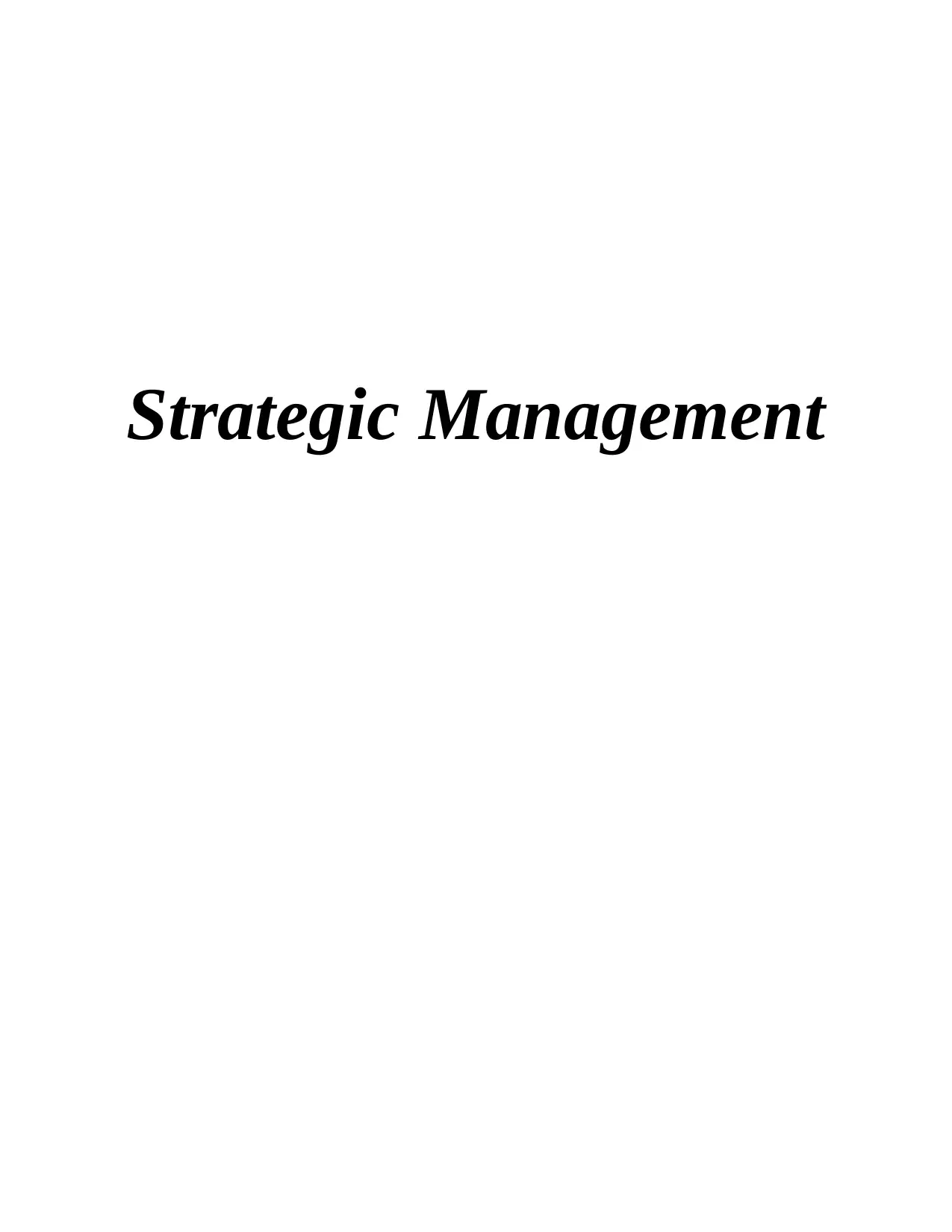
Strategic Management
Secure Best Marks with AI Grader
Need help grading? Try our AI Grader for instant feedback on your assignments.
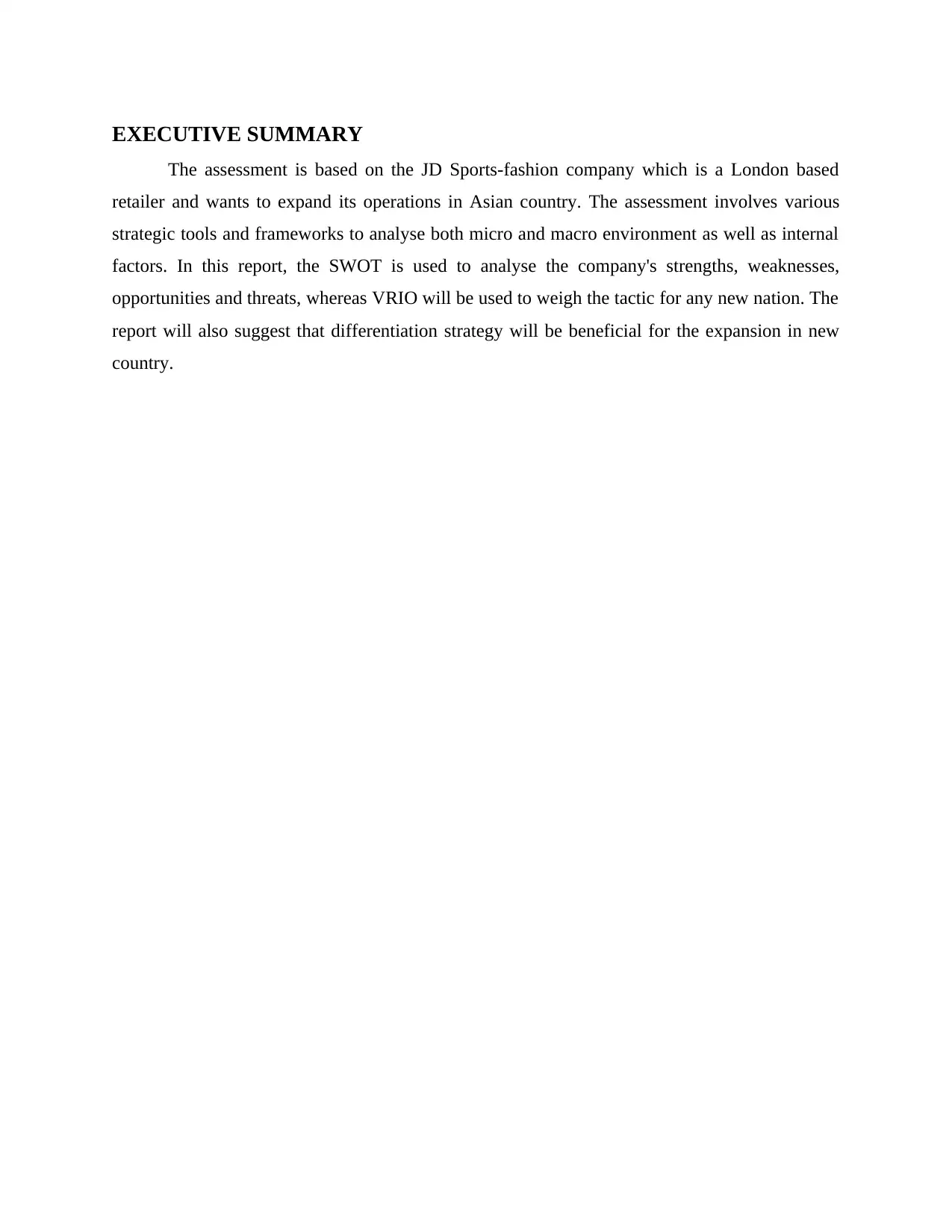
EXECUTIVE SUMMARY
The assessment is based on the JD Sports-fashion company which is a London based
retailer and wants to expand its operations in Asian country. The assessment involves various
strategic tools and frameworks to analyse both micro and macro environment as well as internal
factors. In this report, the SWOT is used to analyse the company's strengths, weaknesses,
opportunities and threats, whereas VRIO will be used to weigh the tactic for any new nation. The
report will also suggest that differentiation strategy will be beneficial for the expansion in new
country.
The assessment is based on the JD Sports-fashion company which is a London based
retailer and wants to expand its operations in Asian country. The assessment involves various
strategic tools and frameworks to analyse both micro and macro environment as well as internal
factors. In this report, the SWOT is used to analyse the company's strengths, weaknesses,
opportunities and threats, whereas VRIO will be used to weigh the tactic for any new nation. The
report will also suggest that differentiation strategy will be beneficial for the expansion in new
country.
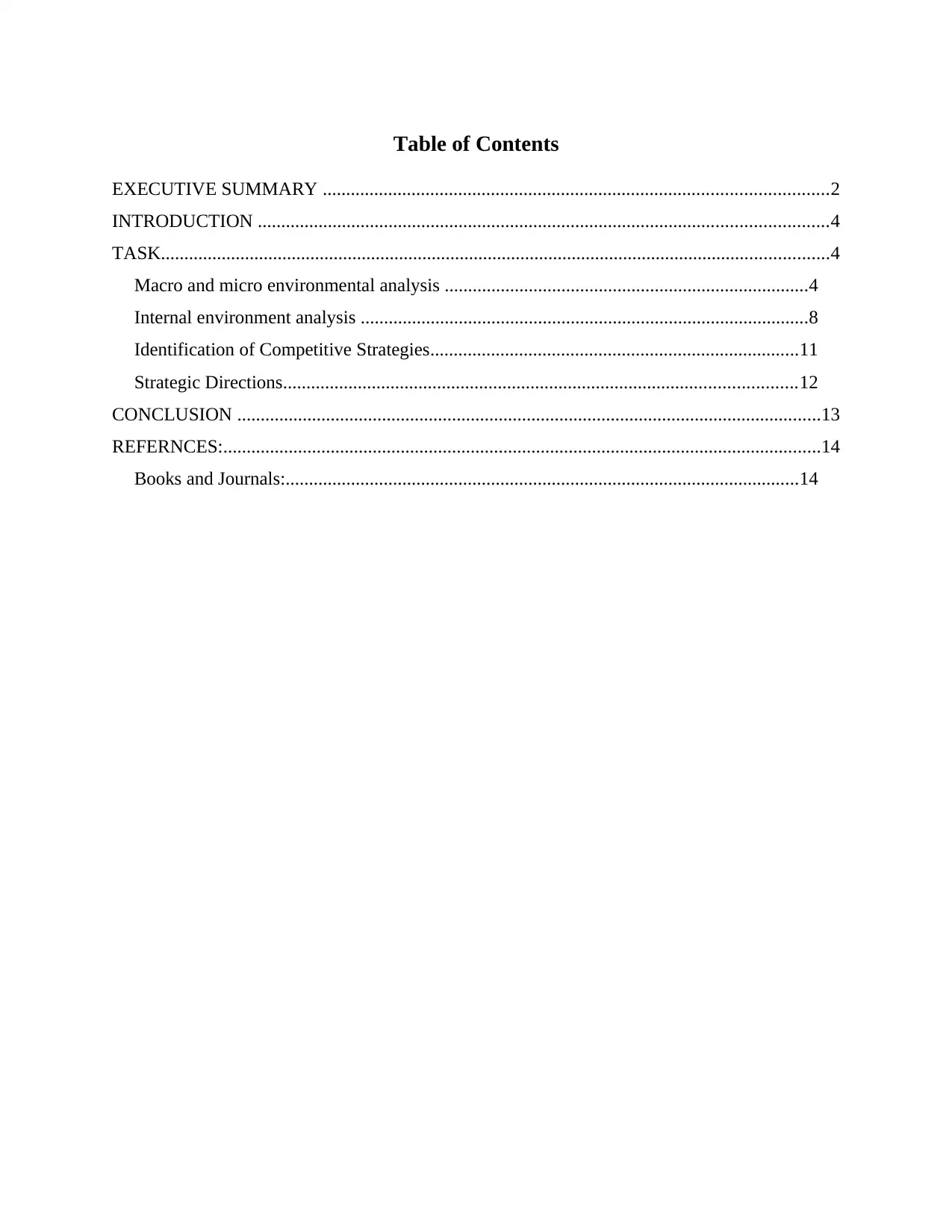
Table of Contents
EXECUTIVE SUMMARY ............................................................................................................2
INTRODUCTION ..........................................................................................................................4
TASK...............................................................................................................................................4
Macro and micro environmental analysis ..............................................................................4
Internal environment analysis ................................................................................................8
Identification of Competitive Strategies...............................................................................11
Strategic Directions..............................................................................................................12
CONCLUSION .............................................................................................................................13
REFERNCES:................................................................................................................................14
Books and Journals:..............................................................................................................14
EXECUTIVE SUMMARY ............................................................................................................2
INTRODUCTION ..........................................................................................................................4
TASK...............................................................................................................................................4
Macro and micro environmental analysis ..............................................................................4
Internal environment analysis ................................................................................................8
Identification of Competitive Strategies...............................................................................11
Strategic Directions..............................................................................................................12
CONCLUSION .............................................................................................................................13
REFERNCES:................................................................................................................................14
Books and Journals:..............................................................................................................14
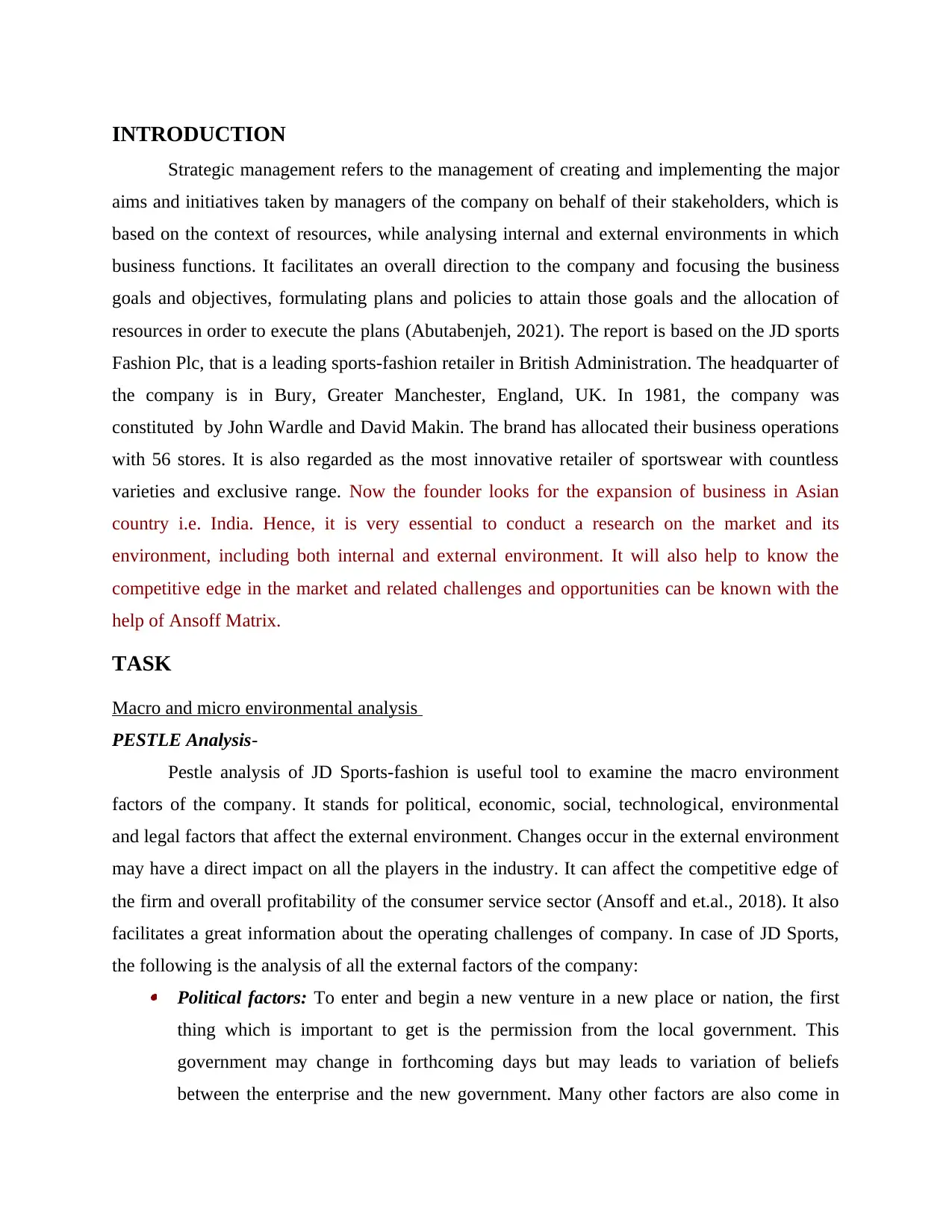
INTRODUCTION
Strategic management refers to the management of creating and implementing the major
aims and initiatives taken by managers of the company on behalf of their stakeholders, which is
based on the context of resources, while analysing internal and external environments in which
business functions. It facilitates an overall direction to the company and focusing the business
goals and objectives, formulating plans and policies to attain those goals and the allocation of
resources in order to execute the plans (Abutabenjeh, 2021). The report is based on the JD sports
Fashion Plc, that is a leading sports-fashion retailer in British Administration. The headquarter of
the company is in Bury, Greater Manchester, England, UK. In 1981, the company was
constituted by John Wardle and David Makin. The brand has allocated their business operations
with 56 stores. It is also regarded as the most innovative retailer of sportswear with countless
varieties and exclusive range. Now the founder looks for the expansion of business in Asian
country i.e. India. Hence, it is very essential to conduct a research on the market and its
environment, including both internal and external environment. It will also help to know the
competitive edge in the market and related challenges and opportunities can be known with the
help of Ansoff Matrix.
TASK
Macro and micro environmental analysis
PESTLE Analysis-
Pestle analysis of JD Sports-fashion is useful tool to examine the macro environment
factors of the company. It stands for political, economic, social, technological, environmental
and legal factors that affect the external environment. Changes occur in the external environment
may have a direct impact on all the players in the industry. It can affect the competitive edge of
the firm and overall profitability of the consumer service sector (Ansoff and et.al., 2018). It also
facilitates a great information about the operating challenges of company. In case of JD Sports,
the following is the analysis of all the external factors of the company: Political factors: To enter and begin a new venture in a new place or nation, the first
thing which is important to get is the permission from the local government. This
government may change in forthcoming days but may leads to variation of beliefs
between the enterprise and the new government. Many other factors are also come in
Strategic management refers to the management of creating and implementing the major
aims and initiatives taken by managers of the company on behalf of their stakeholders, which is
based on the context of resources, while analysing internal and external environments in which
business functions. It facilitates an overall direction to the company and focusing the business
goals and objectives, formulating plans and policies to attain those goals and the allocation of
resources in order to execute the plans (Abutabenjeh, 2021). The report is based on the JD sports
Fashion Plc, that is a leading sports-fashion retailer in British Administration. The headquarter of
the company is in Bury, Greater Manchester, England, UK. In 1981, the company was
constituted by John Wardle and David Makin. The brand has allocated their business operations
with 56 stores. It is also regarded as the most innovative retailer of sportswear with countless
varieties and exclusive range. Now the founder looks for the expansion of business in Asian
country i.e. India. Hence, it is very essential to conduct a research on the market and its
environment, including both internal and external environment. It will also help to know the
competitive edge in the market and related challenges and opportunities can be known with the
help of Ansoff Matrix.
TASK
Macro and micro environmental analysis
PESTLE Analysis-
Pestle analysis of JD Sports-fashion is useful tool to examine the macro environment
factors of the company. It stands for political, economic, social, technological, environmental
and legal factors that affect the external environment. Changes occur in the external environment
may have a direct impact on all the players in the industry. It can affect the competitive edge of
the firm and overall profitability of the consumer service sector (Ansoff and et.al., 2018). It also
facilitates a great information about the operating challenges of company. In case of JD Sports,
the following is the analysis of all the external factors of the company: Political factors: To enter and begin a new venture in a new place or nation, the first
thing which is important to get is the permission from the local government. This
government may change in forthcoming days but may leads to variation of beliefs
between the enterprise and the new government. Many other factors are also come in
Secure Best Marks with AI Grader
Need help grading? Try our AI Grader for instant feedback on your assignments.
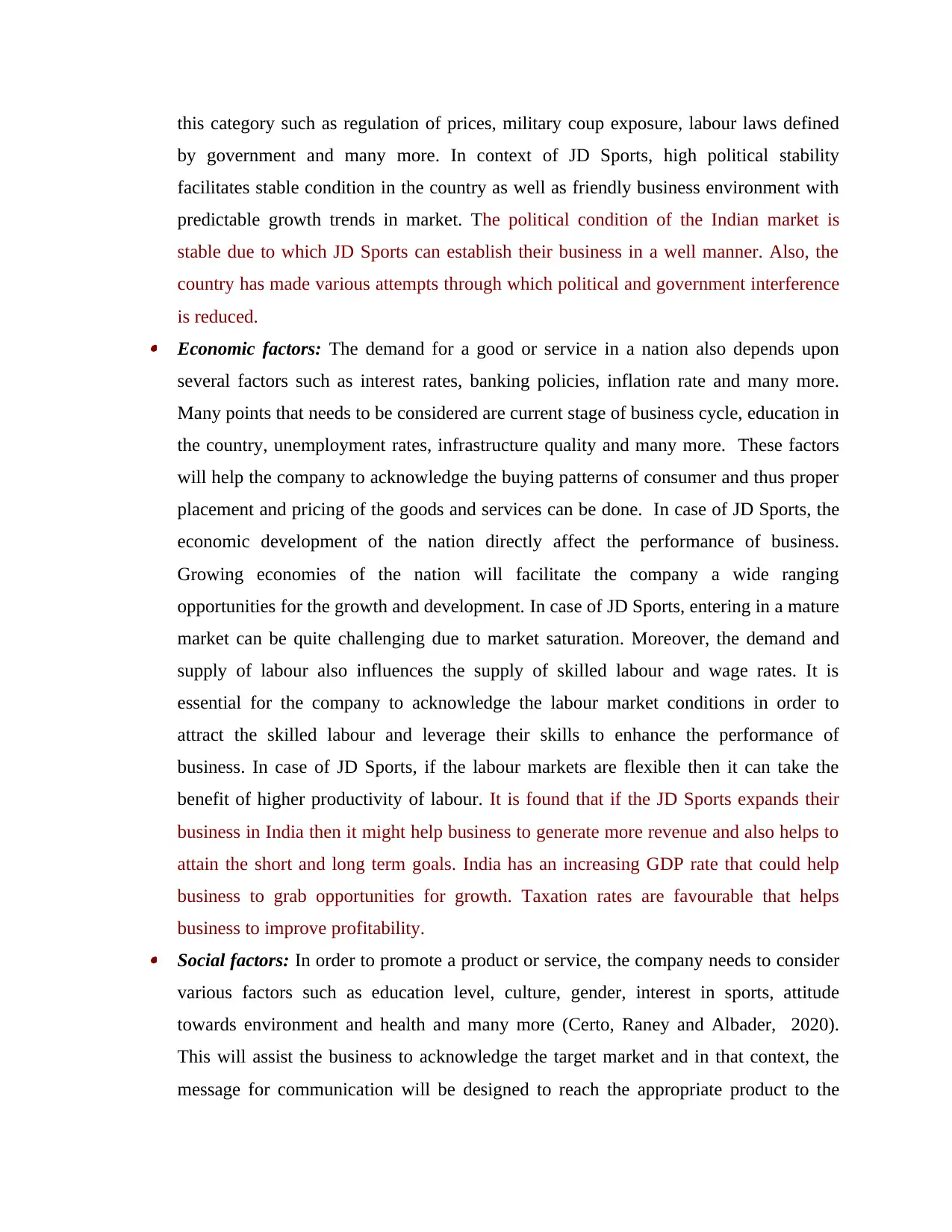
this category such as regulation of prices, military coup exposure, labour laws defined
by government and many more. In context of JD Sports, high political stability
facilitates stable condition in the country as well as friendly business environment with
predictable growth trends in market. The political condition of the Indian market is
stable due to which JD Sports can establish their business in a well manner. Also, the
country has made various attempts through which political and government interference
is reduced. Economic factors: The demand for a good or service in a nation also depends upon
several factors such as interest rates, banking policies, inflation rate and many more.
Many points that needs to be considered are current stage of business cycle, education in
the country, unemployment rates, infrastructure quality and many more. These factors
will help the company to acknowledge the buying patterns of consumer and thus proper
placement and pricing of the goods and services can be done. In case of JD Sports, the
economic development of the nation directly affect the performance of business.
Growing economies of the nation will facilitate the company a wide ranging
opportunities for the growth and development. In case of JD Sports, entering in a mature
market can be quite challenging due to market saturation. Moreover, the demand and
supply of labour also influences the supply of skilled labour and wage rates. It is
essential for the company to acknowledge the labour market conditions in order to
attract the skilled labour and leverage their skills to enhance the performance of
business. In case of JD Sports, if the labour markets are flexible then it can take the
benefit of higher productivity of labour. It is found that if the JD Sports expands their
business in India then it might help business to generate more revenue and also helps to
attain the short and long term goals. India has an increasing GDP rate that could help
business to grab opportunities for growth. Taxation rates are favourable that helps
business to improve profitability. Social factors: In order to promote a product or service, the company needs to consider
various factors such as education level, culture, gender, interest in sports, attitude
towards environment and health and many more (Certo, Raney and Albader, 2020).
This will assist the business to acknowledge the target market and in that context, the
message for communication will be designed to reach the appropriate product to the
by government and many more. In context of JD Sports, high political stability
facilitates stable condition in the country as well as friendly business environment with
predictable growth trends in market. The political condition of the Indian market is
stable due to which JD Sports can establish their business in a well manner. Also, the
country has made various attempts through which political and government interference
is reduced. Economic factors: The demand for a good or service in a nation also depends upon
several factors such as interest rates, banking policies, inflation rate and many more.
Many points that needs to be considered are current stage of business cycle, education in
the country, unemployment rates, infrastructure quality and many more. These factors
will help the company to acknowledge the buying patterns of consumer and thus proper
placement and pricing of the goods and services can be done. In case of JD Sports, the
economic development of the nation directly affect the performance of business.
Growing economies of the nation will facilitate the company a wide ranging
opportunities for the growth and development. In case of JD Sports, entering in a mature
market can be quite challenging due to market saturation. Moreover, the demand and
supply of labour also influences the supply of skilled labour and wage rates. It is
essential for the company to acknowledge the labour market conditions in order to
attract the skilled labour and leverage their skills to enhance the performance of
business. In case of JD Sports, if the labour markets are flexible then it can take the
benefit of higher productivity of labour. It is found that if the JD Sports expands their
business in India then it might help business to generate more revenue and also helps to
attain the short and long term goals. India has an increasing GDP rate that could help
business to grab opportunities for growth. Taxation rates are favourable that helps
business to improve profitability. Social factors: In order to promote a product or service, the company needs to consider
various factors such as education level, culture, gender, interest in sports, attitude
towards environment and health and many more (Certo, Raney and Albader, 2020).
This will assist the business to acknowledge the target market and in that context, the
message for communication will be designed to reach the appropriate product to the
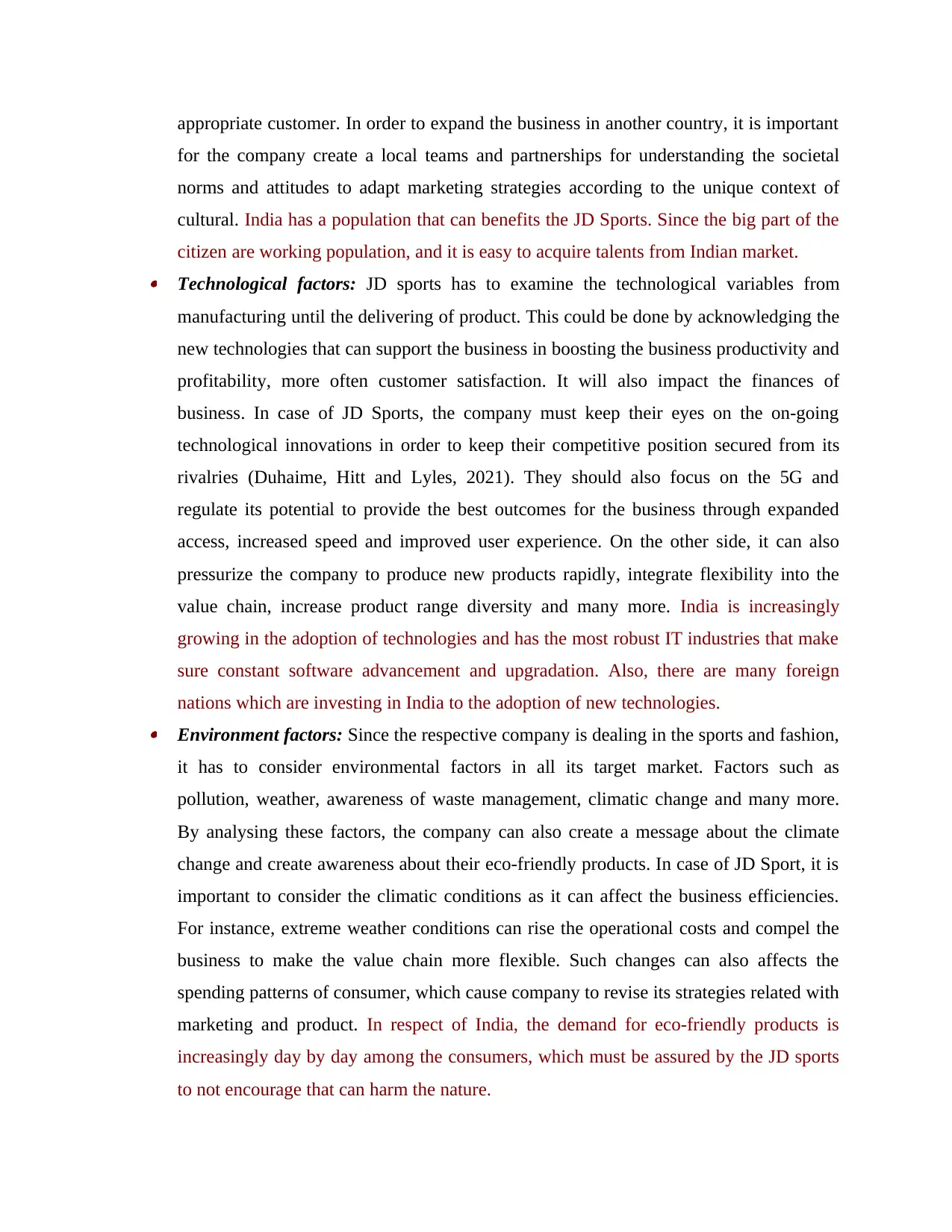
appropriate customer. In order to expand the business in another country, it is important
for the company create a local teams and partnerships for understanding the societal
norms and attitudes to adapt marketing strategies according to the unique context of
cultural. India has a population that can benefits the JD Sports. Since the big part of the
citizen are working population, and it is easy to acquire talents from Indian market. Technological factors: JD sports has to examine the technological variables from
manufacturing until the delivering of product. This could be done by acknowledging the
new technologies that can support the business in boosting the business productivity and
profitability, more often customer satisfaction. It will also impact the finances of
business. In case of JD Sports, the company must keep their eyes on the on-going
technological innovations in order to keep their competitive position secured from its
rivalries (Duhaime, Hitt and Lyles, 2021). They should also focus on the 5G and
regulate its potential to provide the best outcomes for the business through expanded
access, increased speed and improved user experience. On the other side, it can also
pressurize the company to produce new products rapidly, integrate flexibility into the
value chain, increase product range diversity and many more. India is increasingly
growing in the adoption of technologies and has the most robust IT industries that make
sure constant software advancement and upgradation. Also, there are many foreign
nations which are investing in India to the adoption of new technologies. Environment factors: Since the respective company is dealing in the sports and fashion,
it has to consider environmental factors in all its target market. Factors such as
pollution, weather, awareness of waste management, climatic change and many more.
By analysing these factors, the company can also create a message about the climate
change and create awareness about their eco-friendly products. In case of JD Sport, it is
important to consider the climatic conditions as it can affect the business efficiencies.
For instance, extreme weather conditions can rise the operational costs and compel the
business to make the value chain more flexible. Such changes can also affects the
spending patterns of consumer, which cause company to revise its strategies related with
marketing and product. In respect of India, the demand for eco-friendly products is
increasingly day by day among the consumers, which must be assured by the JD sports
to not encourage that can harm the nature.
for the company create a local teams and partnerships for understanding the societal
norms and attitudes to adapt marketing strategies according to the unique context of
cultural. India has a population that can benefits the JD Sports. Since the big part of the
citizen are working population, and it is easy to acquire talents from Indian market. Technological factors: JD sports has to examine the technological variables from
manufacturing until the delivering of product. This could be done by acknowledging the
new technologies that can support the business in boosting the business productivity and
profitability, more often customer satisfaction. It will also impact the finances of
business. In case of JD Sports, the company must keep their eyes on the on-going
technological innovations in order to keep their competitive position secured from its
rivalries (Duhaime, Hitt and Lyles, 2021). They should also focus on the 5G and
regulate its potential to provide the best outcomes for the business through expanded
access, increased speed and improved user experience. On the other side, it can also
pressurize the company to produce new products rapidly, integrate flexibility into the
value chain, increase product range diversity and many more. India is increasingly
growing in the adoption of technologies and has the most robust IT industries that make
sure constant software advancement and upgradation. Also, there are many foreign
nations which are investing in India to the adoption of new technologies. Environment factors: Since the respective company is dealing in the sports and fashion,
it has to consider environmental factors in all its target market. Factors such as
pollution, weather, awareness of waste management, climatic change and many more.
By analysing these factors, the company can also create a message about the climate
change and create awareness about their eco-friendly products. In case of JD Sport, it is
important to consider the climatic conditions as it can affect the business efficiencies.
For instance, extreme weather conditions can rise the operational costs and compel the
business to make the value chain more flexible. Such changes can also affects the
spending patterns of consumer, which cause company to revise its strategies related with
marketing and product. In respect of India, the demand for eco-friendly products is
increasingly day by day among the consumers, which must be assured by the JD sports
to not encourage that can harm the nature.
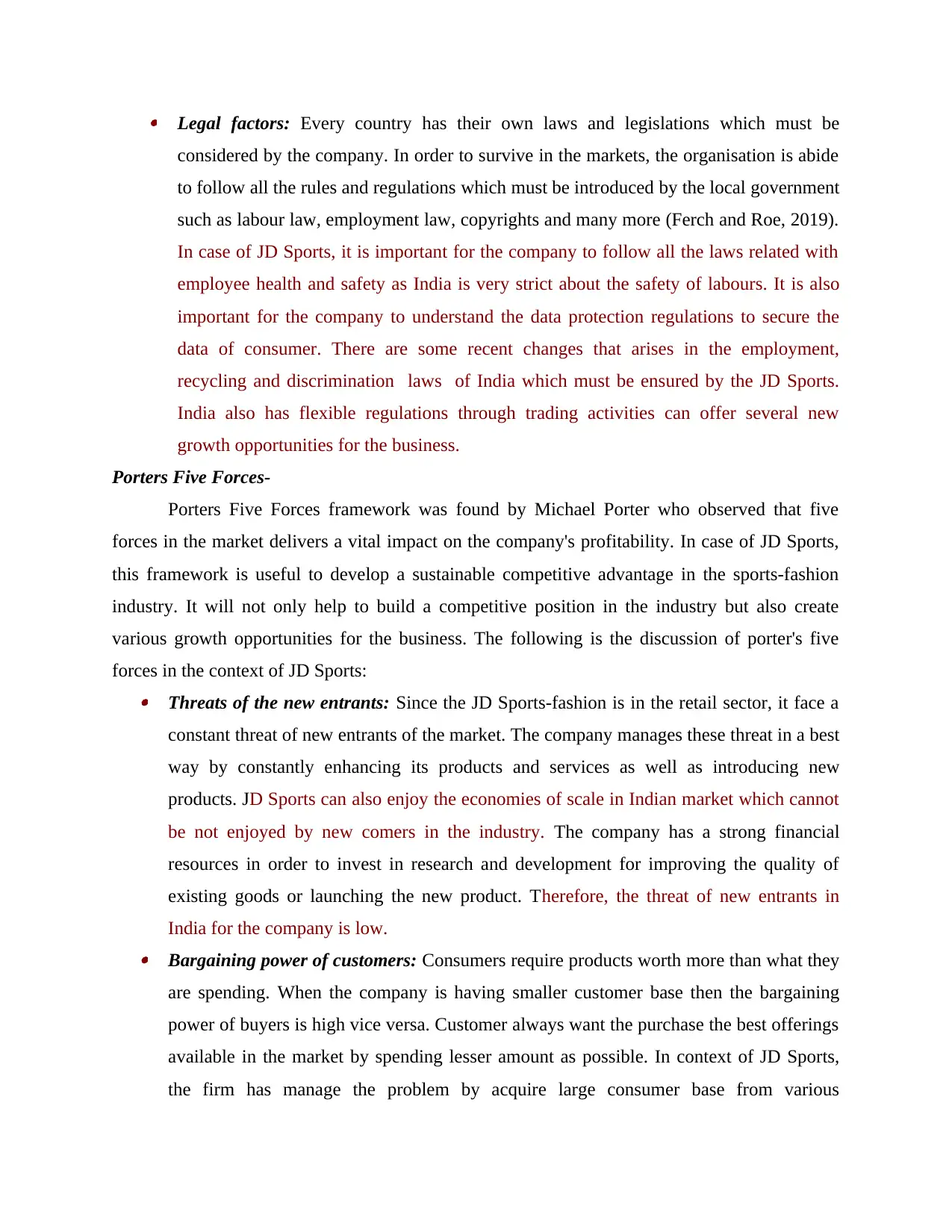
Legal factors: Every country has their own laws and legislations which must be
considered by the company. In order to survive in the markets, the organisation is abide
to follow all the rules and regulations which must be introduced by the local government
such as labour law, employment law, copyrights and many more (Ferch and Roe, 2019).
In case of JD Sports, it is important for the company to follow all the laws related with
employee health and safety as India is very strict about the safety of labours. It is also
important for the company to understand the data protection regulations to secure the
data of consumer. There are some recent changes that arises in the employment,
recycling and discrimination laws of India which must be ensured by the JD Sports.
India also has flexible regulations through trading activities can offer several new
growth opportunities for the business.
Porters Five Forces-
Porters Five Forces framework was found by Michael Porter who observed that five
forces in the market delivers a vital impact on the company's profitability. In case of JD Sports,
this framework is useful to develop a sustainable competitive advantage in the sports-fashion
industry. It will not only help to build a competitive position in the industry but also create
various growth opportunities for the business. The following is the discussion of porter's five
forces in the context of JD Sports: Threats of the new entrants: Since the JD Sports-fashion is in the retail sector, it face a
constant threat of new entrants of the market. The company manages these threat in a best
way by constantly enhancing its products and services as well as introducing new
products. JD Sports can also enjoy the economies of scale in Indian market which cannot
be not enjoyed by new comers in the industry. The company has a strong financial
resources in order to invest in research and development for improving the quality of
existing goods or launching the new product. Therefore, the threat of new entrants in
India for the company is low. Bargaining power of customers: Consumers require products worth more than what they
are spending. When the company is having smaller customer base then the bargaining
power of buyers is high vice versa. Customer always want the purchase the best offerings
available in the market by spending lesser amount as possible. In context of JD Sports,
the firm has manage the problem by acquire large consumer base from various
considered by the company. In order to survive in the markets, the organisation is abide
to follow all the rules and regulations which must be introduced by the local government
such as labour law, employment law, copyrights and many more (Ferch and Roe, 2019).
In case of JD Sports, it is important for the company to follow all the laws related with
employee health and safety as India is very strict about the safety of labours. It is also
important for the company to understand the data protection regulations to secure the
data of consumer. There are some recent changes that arises in the employment,
recycling and discrimination laws of India which must be ensured by the JD Sports.
India also has flexible regulations through trading activities can offer several new
growth opportunities for the business.
Porters Five Forces-
Porters Five Forces framework was found by Michael Porter who observed that five
forces in the market delivers a vital impact on the company's profitability. In case of JD Sports,
this framework is useful to develop a sustainable competitive advantage in the sports-fashion
industry. It will not only help to build a competitive position in the industry but also create
various growth opportunities for the business. The following is the discussion of porter's five
forces in the context of JD Sports: Threats of the new entrants: Since the JD Sports-fashion is in the retail sector, it face a
constant threat of new entrants of the market. The company manages these threat in a best
way by constantly enhancing its products and services as well as introducing new
products. JD Sports can also enjoy the economies of scale in Indian market which cannot
be not enjoyed by new comers in the industry. The company has a strong financial
resources in order to invest in research and development for improving the quality of
existing goods or launching the new product. Therefore, the threat of new entrants in
India for the company is low. Bargaining power of customers: Consumers require products worth more than what they
are spending. When the company is having smaller customer base then the bargaining
power of buyers is high vice versa. Customer always want the purchase the best offerings
available in the market by spending lesser amount as possible. In context of JD Sports,
the firm has manage the problem by acquire large consumer base from various
Paraphrase This Document
Need a fresh take? Get an instant paraphrase of this document with our AI Paraphraser
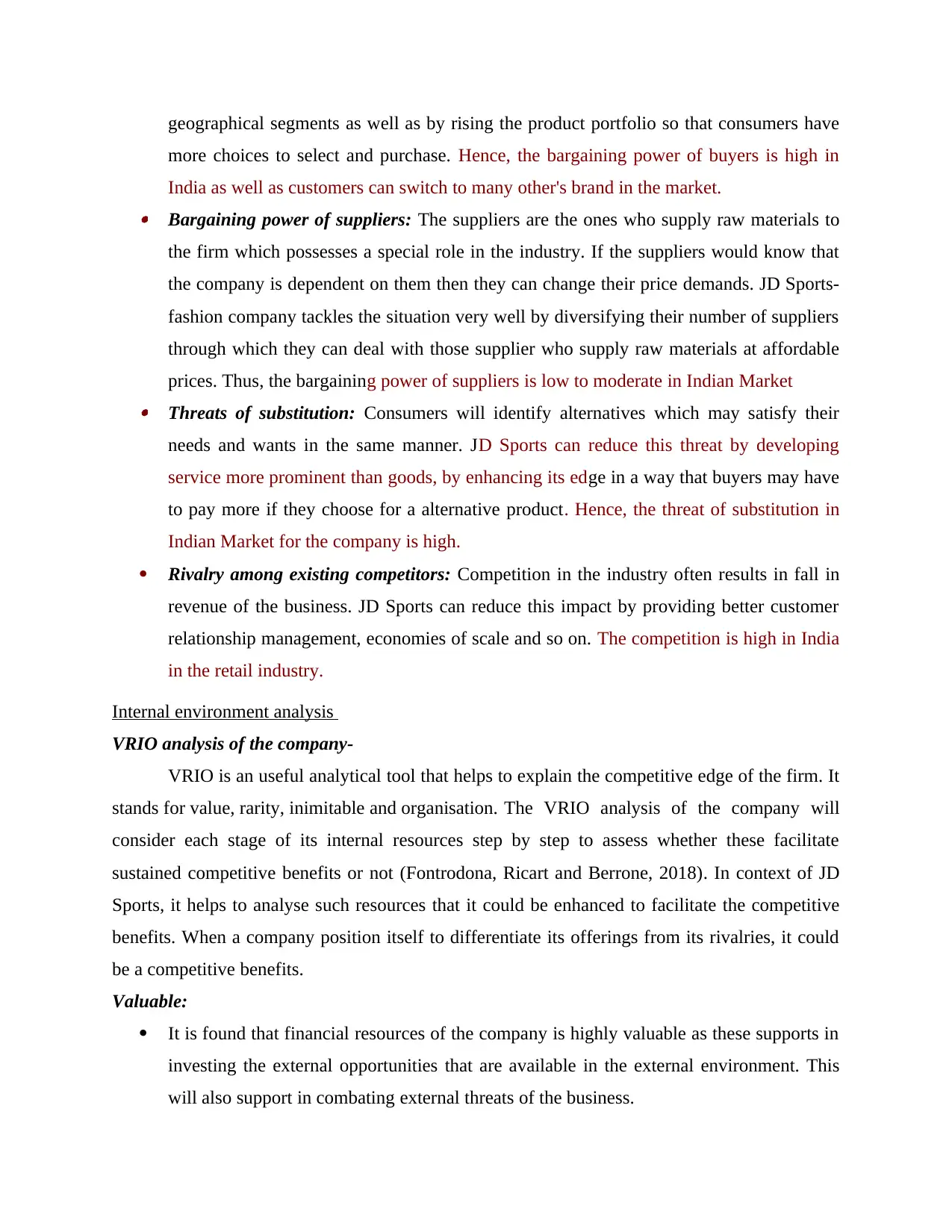
geographical segments as well as by rising the product portfolio so that consumers have
more choices to select and purchase. Hence, the bargaining power of buyers is high in
India as well as customers can switch to many other's brand in the market. Bargaining power of suppliers: The suppliers are the ones who supply raw materials to
the firm which possesses a special role in the industry. If the suppliers would know that
the company is dependent on them then they can change their price demands. JD Sports-
fashion company tackles the situation very well by diversifying their number of suppliers
through which they can deal with those supplier who supply raw materials at affordable
prices. Thus, the bargaining power of suppliers is low to moderate in Indian Market Threats of substitution: Consumers will identify alternatives which may satisfy their
needs and wants in the same manner. JD Sports can reduce this threat by developing
service more prominent than goods, by enhancing its edge in a way that buyers may have
to pay more if they choose for a alternative product. Hence, the threat of substitution in
Indian Market for the company is high.
Rivalry among existing competitors: Competition in the industry often results in fall in
revenue of the business. JD Sports can reduce this impact by providing better customer
relationship management, economies of scale and so on. The competition is high in India
in the retail industry.
Internal environment analysis
VRIO analysis of the company-
VRIO is an useful analytical tool that helps to explain the competitive edge of the firm. It
stands for value, rarity, inimitable and organisation. The VRIO analysis of the company will
consider each stage of its internal resources step by step to assess whether these facilitate
sustained competitive benefits or not (Fontrodona, Ricart and Berrone, 2018). In context of JD
Sports, it helps to analyse such resources that it could be enhanced to facilitate the competitive
benefits. When a company position itself to differentiate its offerings from its rivalries, it could
be a competitive benefits.
Valuable:
It is found that financial resources of the company is highly valuable as these supports in
investing the external opportunities that are available in the external environment. This
will also support in combating external threats of the business.
more choices to select and purchase. Hence, the bargaining power of buyers is high in
India as well as customers can switch to many other's brand in the market. Bargaining power of suppliers: The suppliers are the ones who supply raw materials to
the firm which possesses a special role in the industry. If the suppliers would know that
the company is dependent on them then they can change their price demands. JD Sports-
fashion company tackles the situation very well by diversifying their number of suppliers
through which they can deal with those supplier who supply raw materials at affordable
prices. Thus, the bargaining power of suppliers is low to moderate in Indian Market Threats of substitution: Consumers will identify alternatives which may satisfy their
needs and wants in the same manner. JD Sports can reduce this threat by developing
service more prominent than goods, by enhancing its edge in a way that buyers may have
to pay more if they choose for a alternative product. Hence, the threat of substitution in
Indian Market for the company is high.
Rivalry among existing competitors: Competition in the industry often results in fall in
revenue of the business. JD Sports can reduce this impact by providing better customer
relationship management, economies of scale and so on. The competition is high in India
in the retail industry.
Internal environment analysis
VRIO analysis of the company-
VRIO is an useful analytical tool that helps to explain the competitive edge of the firm. It
stands for value, rarity, inimitable and organisation. The VRIO analysis of the company will
consider each stage of its internal resources step by step to assess whether these facilitate
sustained competitive benefits or not (Fontrodona, Ricart and Berrone, 2018). In context of JD
Sports, it helps to analyse such resources that it could be enhanced to facilitate the competitive
benefits. When a company position itself to differentiate its offerings from its rivalries, it could
be a competitive benefits.
Valuable:
It is found that financial resources of the company is highly valuable as these supports in
investing the external opportunities that are available in the external environment. This
will also support in combating external threats of the business.
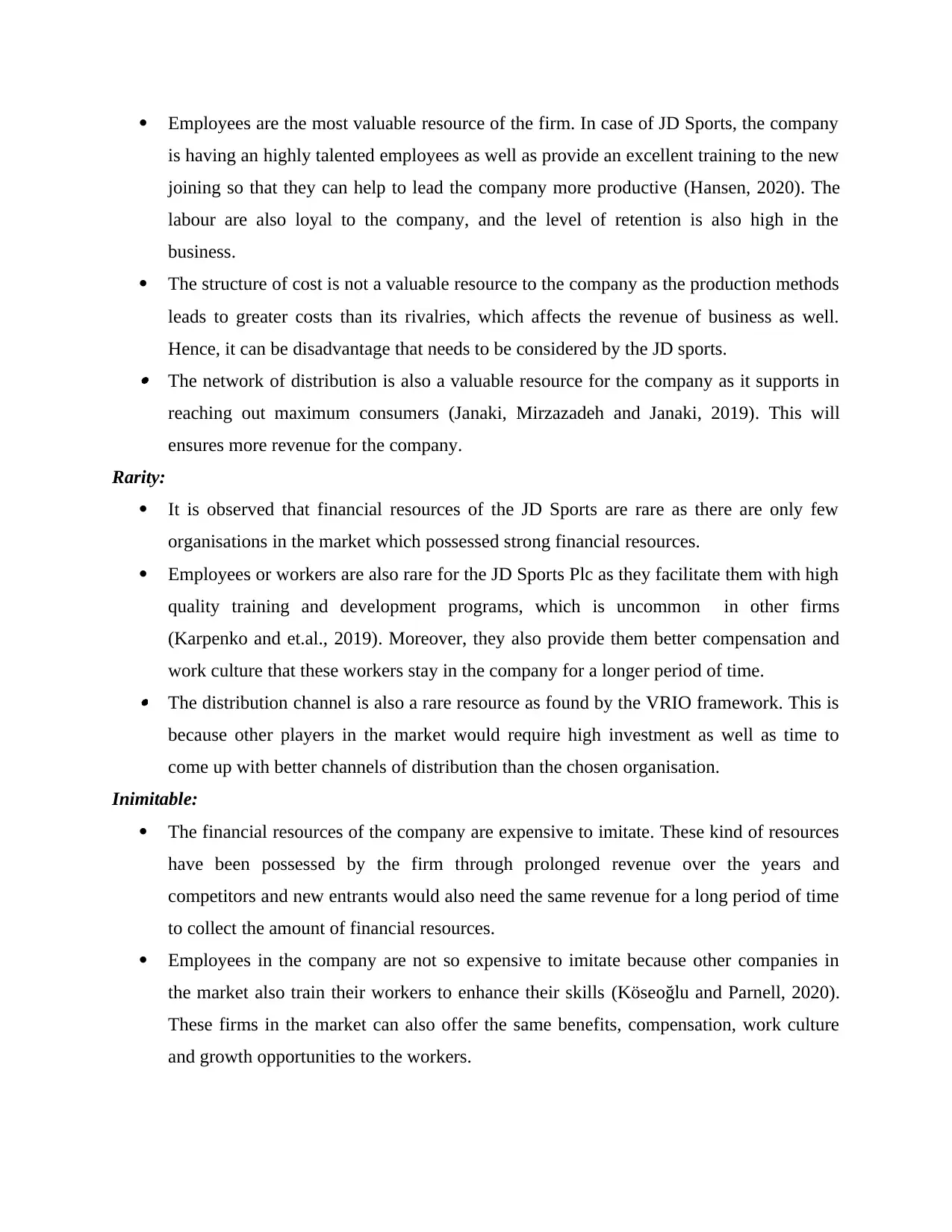
Employees are the most valuable resource of the firm. In case of JD Sports, the company
is having an highly talented employees as well as provide an excellent training to the new
joining so that they can help to lead the company more productive (Hansen, 2020). The
labour are also loyal to the company, and the level of retention is also high in the
business.
The structure of cost is not a valuable resource to the company as the production methods
leads to greater costs than its rivalries, which affects the revenue of business as well.
Hence, it can be disadvantage that needs to be considered by the JD sports. The network of distribution is also a valuable resource for the company as it supports in
reaching out maximum consumers (Janaki, Mirzazadeh and Janaki, 2019). This will
ensures more revenue for the company.
Rarity:
It is observed that financial resources of the JD Sports are rare as there are only few
organisations in the market which possessed strong financial resources.
Employees or workers are also rare for the JD Sports Plc as they facilitate them with high
quality training and development programs, which is uncommon in other firms
(Karpenko and et.al., 2019). Moreover, they also provide them better compensation and
work culture that these workers stay in the company for a longer period of time. The distribution channel is also a rare resource as found by the VRIO framework. This is
because other players in the market would require high investment as well as time to
come up with better channels of distribution than the chosen organisation.
Inimitable:
The financial resources of the company are expensive to imitate. These kind of resources
have been possessed by the firm through prolonged revenue over the years and
competitors and new entrants would also need the same revenue for a long period of time
to collect the amount of financial resources.
Employees in the company are not so expensive to imitate because other companies in
the market also train their workers to enhance their skills (Köseoğlu and Parnell, 2020).
These firms in the market can also offer the same benefits, compensation, work culture
and growth opportunities to the workers.
is having an highly talented employees as well as provide an excellent training to the new
joining so that they can help to lead the company more productive (Hansen, 2020). The
labour are also loyal to the company, and the level of retention is also high in the
business.
The structure of cost is not a valuable resource to the company as the production methods
leads to greater costs than its rivalries, which affects the revenue of business as well.
Hence, it can be disadvantage that needs to be considered by the JD sports. The network of distribution is also a valuable resource for the company as it supports in
reaching out maximum consumers (Janaki, Mirzazadeh and Janaki, 2019). This will
ensures more revenue for the company.
Rarity:
It is observed that financial resources of the JD Sports are rare as there are only few
organisations in the market which possessed strong financial resources.
Employees or workers are also rare for the JD Sports Plc as they facilitate them with high
quality training and development programs, which is uncommon in other firms
(Karpenko and et.al., 2019). Moreover, they also provide them better compensation and
work culture that these workers stay in the company for a longer period of time. The distribution channel is also a rare resource as found by the VRIO framework. This is
because other players in the market would require high investment as well as time to
come up with better channels of distribution than the chosen organisation.
Inimitable:
The financial resources of the company are expensive to imitate. These kind of resources
have been possessed by the firm through prolonged revenue over the years and
competitors and new entrants would also need the same revenue for a long period of time
to collect the amount of financial resources.
Employees in the company are not so expensive to imitate because other companies in
the market also train their workers to enhance their skills (Köseoğlu and Parnell, 2020).
These firms in the market can also offer the same benefits, compensation, work culture
and growth opportunities to the workers.
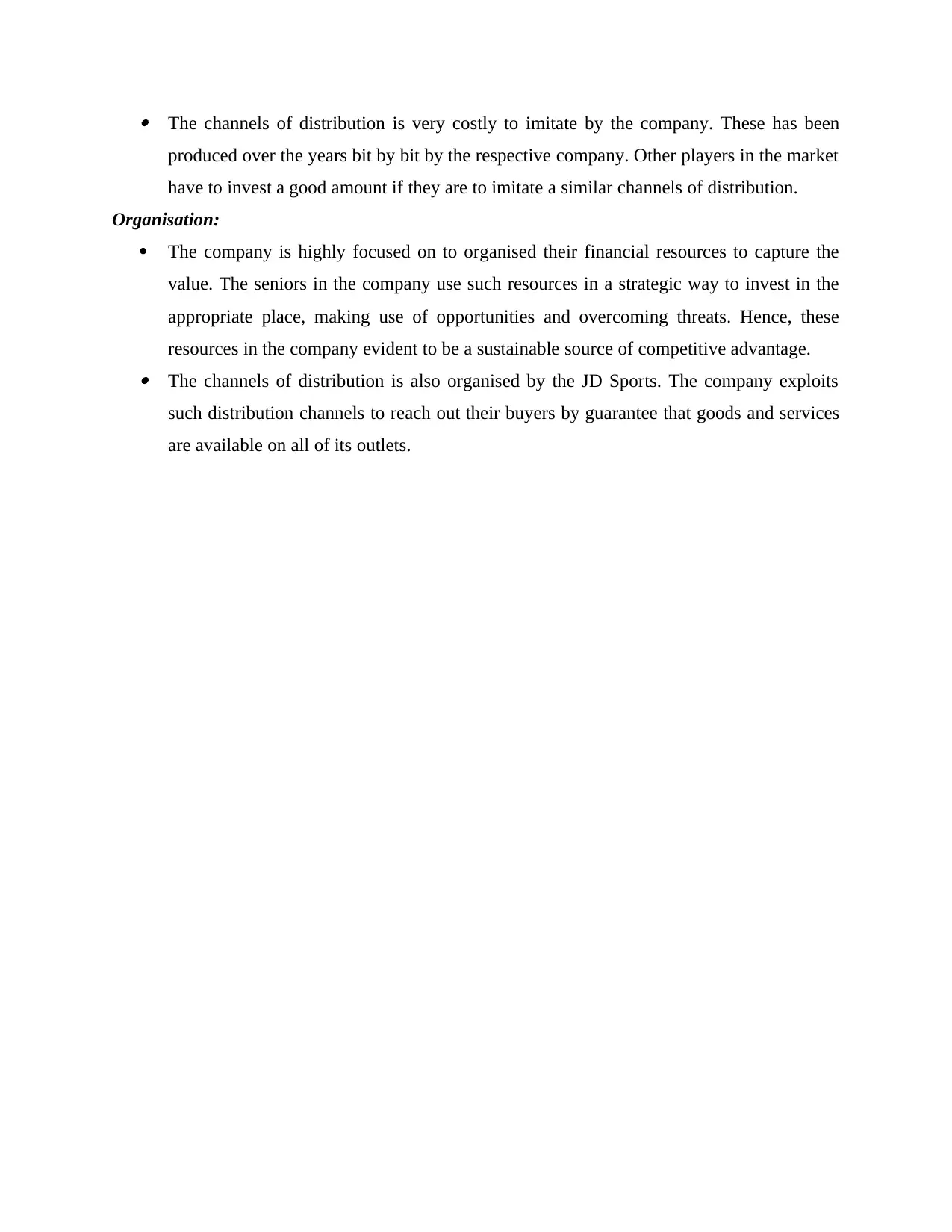
The channels of distribution is very costly to imitate by the company. These has been
produced over the years bit by bit by the respective company. Other players in the market
have to invest a good amount if they are to imitate a similar channels of distribution.
Organisation:
The company is highly focused on to organised their financial resources to capture the
value. The seniors in the company use such resources in a strategic way to invest in the
appropriate place, making use of opportunities and overcoming threats. Hence, these
resources in the company evident to be a sustainable source of competitive advantage. The channels of distribution is also organised by the JD Sports. The company exploits
such distribution channels to reach out their buyers by guarantee that goods and services
are available on all of its outlets.
produced over the years bit by bit by the respective company. Other players in the market
have to invest a good amount if they are to imitate a similar channels of distribution.
Organisation:
The company is highly focused on to organised their financial resources to capture the
value. The seniors in the company use such resources in a strategic way to invest in the
appropriate place, making use of opportunities and overcoming threats. Hence, these
resources in the company evident to be a sustainable source of competitive advantage. The channels of distribution is also organised by the JD Sports. The company exploits
such distribution channels to reach out their buyers by guarantee that goods and services
are available on all of its outlets.
Secure Best Marks with AI Grader
Need help grading? Try our AI Grader for instant feedback on your assignments.
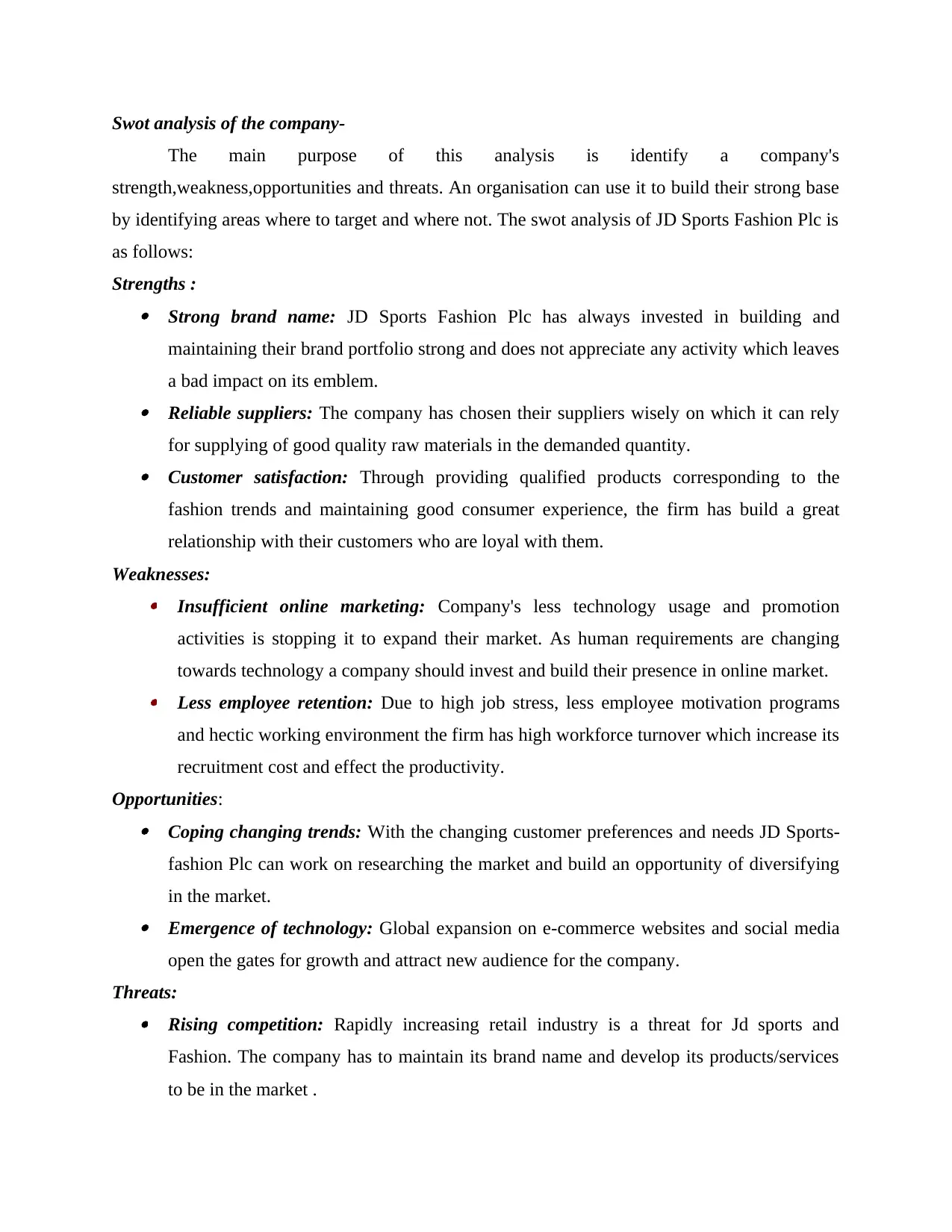
Swot analysis of the company-
The main purpose of this analysis is identify a company's
strength,weakness,opportunities and threats. An organisation can use it to build their strong base
by identifying areas where to target and where not. The swot analysis of JD Sports Fashion Plc is
as follows:
Strengths : Strong brand name: JD Sports Fashion Plc has always invested in building and
maintaining their brand portfolio strong and does not appreciate any activity which leaves
a bad impact on its emblem. Reliable suppliers: The company has chosen their suppliers wisely on which it can rely
for supplying of good quality raw materials in the demanded quantity. Customer satisfaction: Through providing qualified products corresponding to the
fashion trends and maintaining good consumer experience, the firm has build a great
relationship with their customers who are loyal with them.
Weaknesses: Insufficient online marketing: Company's less technology usage and promotion
activities is stopping it to expand their market. As human requirements are changing
towards technology a company should invest and build their presence in online market. Less employee retention: Due to high job stress, less employee motivation programs
and hectic working environment the firm has high workforce turnover which increase its
recruitment cost and effect the productivity.
Opportunities: Coping changing trends: With the changing customer preferences and needs JD Sports-
fashion Plc can work on researching the market and build an opportunity of diversifying
in the market. Emergence of technology: Global expansion on e-commerce websites and social media
open the gates for growth and attract new audience for the company.
Threats: Rising competition: Rapidly increasing retail industry is a threat for Jd sports and
Fashion. The company has to maintain its brand name and develop its products/services
to be in the market .
The main purpose of this analysis is identify a company's
strength,weakness,opportunities and threats. An organisation can use it to build their strong base
by identifying areas where to target and where not. The swot analysis of JD Sports Fashion Plc is
as follows:
Strengths : Strong brand name: JD Sports Fashion Plc has always invested in building and
maintaining their brand portfolio strong and does not appreciate any activity which leaves
a bad impact on its emblem. Reliable suppliers: The company has chosen their suppliers wisely on which it can rely
for supplying of good quality raw materials in the demanded quantity. Customer satisfaction: Through providing qualified products corresponding to the
fashion trends and maintaining good consumer experience, the firm has build a great
relationship with their customers who are loyal with them.
Weaknesses: Insufficient online marketing: Company's less technology usage and promotion
activities is stopping it to expand their market. As human requirements are changing
towards technology a company should invest and build their presence in online market. Less employee retention: Due to high job stress, less employee motivation programs
and hectic working environment the firm has high workforce turnover which increase its
recruitment cost and effect the productivity.
Opportunities: Coping changing trends: With the changing customer preferences and needs JD Sports-
fashion Plc can work on researching the market and build an opportunity of diversifying
in the market. Emergence of technology: Global expansion on e-commerce websites and social media
open the gates for growth and attract new audience for the company.
Threats: Rising competition: Rapidly increasing retail industry is a threat for Jd sports and
Fashion. The company has to maintain its brand name and develop its products/services
to be in the market .
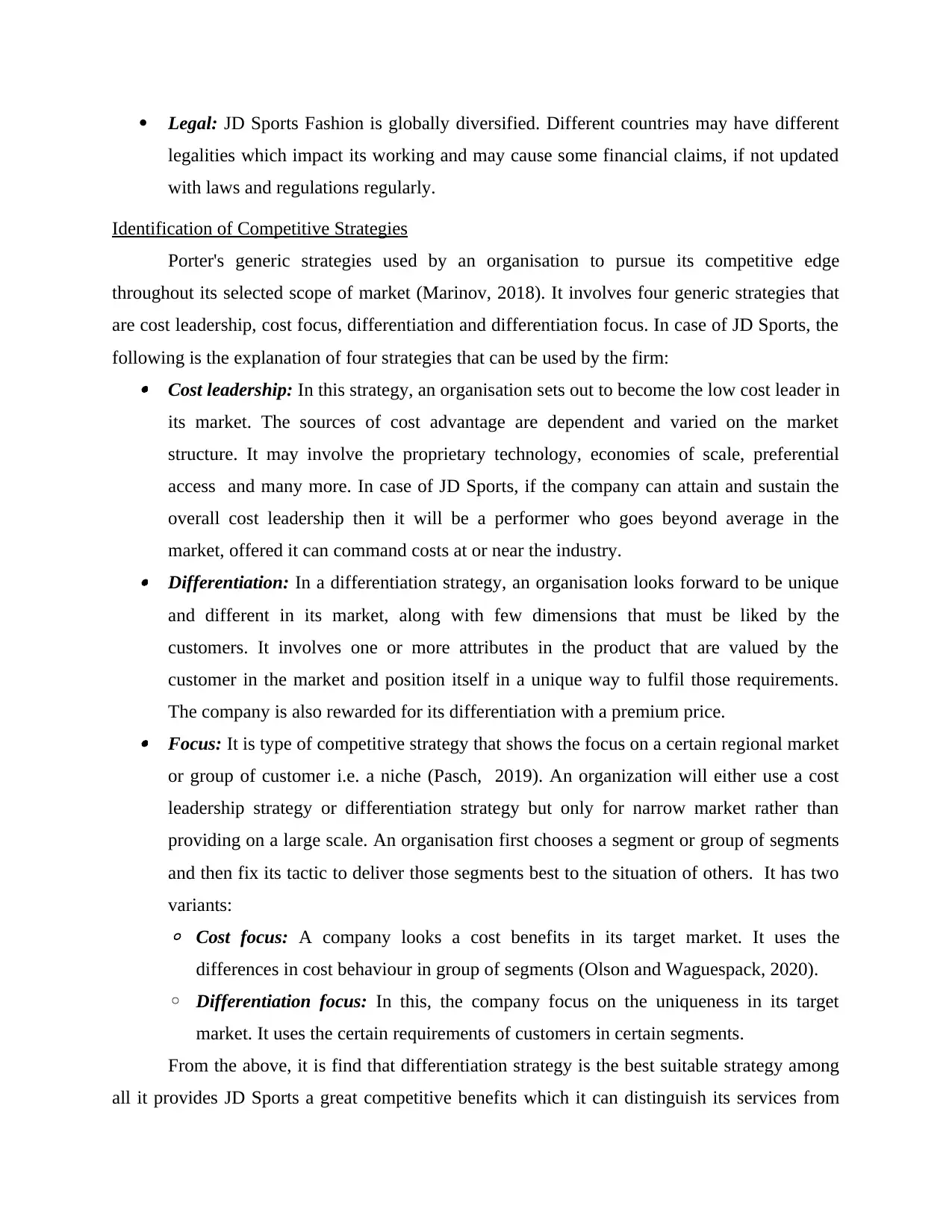
Legal: JD Sports Fashion is globally diversified. Different countries may have different
legalities which impact its working and may cause some financial claims, if not updated
with laws and regulations regularly.
Identification of Competitive Strategies
Porter's generic strategies used by an organisation to pursue its competitive edge
throughout its selected scope of market (Marinov, 2018). It involves four generic strategies that
are cost leadership, cost focus, differentiation and differentiation focus. In case of JD Sports, the
following is the explanation of four strategies that can be used by the firm: Cost leadership: In this strategy, an organisation sets out to become the low cost leader in
its market. The sources of cost advantage are dependent and varied on the market
structure. It may involve the proprietary technology, economies of scale, preferential
access and many more. In case of JD Sports, if the company can attain and sustain the
overall cost leadership then it will be a performer who goes beyond average in the
market, offered it can command costs at or near the industry. Differentiation: In a differentiation strategy, an organisation looks forward to be unique
and different in its market, along with few dimensions that must be liked by the
customers. It involves one or more attributes in the product that are valued by the
customer in the market and position itself in a unique way to fulfil those requirements.
The company is also rewarded for its differentiation with a premium price. Focus: It is type of competitive strategy that shows the focus on a certain regional market
or group of customer i.e. a niche (Pasch, 2019). An organization will either use a cost
leadership strategy or differentiation strategy but only for narrow market rather than
providing on a large scale. An organisation first chooses a segment or group of segments
and then fix its tactic to deliver those segments best to the situation of others. It has two
variants:
◦ Cost focus: A company looks a cost benefits in its target market. It uses the
differences in cost behaviour in group of segments (Olson and Waguespack, 2020).
◦ Differentiation focus: In this, the company focus on the uniqueness in its target
market. It uses the certain requirements of customers in certain segments.
From the above, it is find that differentiation strategy is the best suitable strategy among
all it provides JD Sports a great competitive benefits which it can distinguish its services from
legalities which impact its working and may cause some financial claims, if not updated
with laws and regulations regularly.
Identification of Competitive Strategies
Porter's generic strategies used by an organisation to pursue its competitive edge
throughout its selected scope of market (Marinov, 2018). It involves four generic strategies that
are cost leadership, cost focus, differentiation and differentiation focus. In case of JD Sports, the
following is the explanation of four strategies that can be used by the firm: Cost leadership: In this strategy, an organisation sets out to become the low cost leader in
its market. The sources of cost advantage are dependent and varied on the market
structure. It may involve the proprietary technology, economies of scale, preferential
access and many more. In case of JD Sports, if the company can attain and sustain the
overall cost leadership then it will be a performer who goes beyond average in the
market, offered it can command costs at or near the industry. Differentiation: In a differentiation strategy, an organisation looks forward to be unique
and different in its market, along with few dimensions that must be liked by the
customers. It involves one or more attributes in the product that are valued by the
customer in the market and position itself in a unique way to fulfil those requirements.
The company is also rewarded for its differentiation with a premium price. Focus: It is type of competitive strategy that shows the focus on a certain regional market
or group of customer i.e. a niche (Pasch, 2019). An organization will either use a cost
leadership strategy or differentiation strategy but only for narrow market rather than
providing on a large scale. An organisation first chooses a segment or group of segments
and then fix its tactic to deliver those segments best to the situation of others. It has two
variants:
◦ Cost focus: A company looks a cost benefits in its target market. It uses the
differences in cost behaviour in group of segments (Olson and Waguespack, 2020).
◦ Differentiation focus: In this, the company focus on the uniqueness in its target
market. It uses the certain requirements of customers in certain segments.
From the above, it is find that differentiation strategy is the best suitable strategy among
all it provides JD Sports a great competitive benefits which it can distinguish its services from
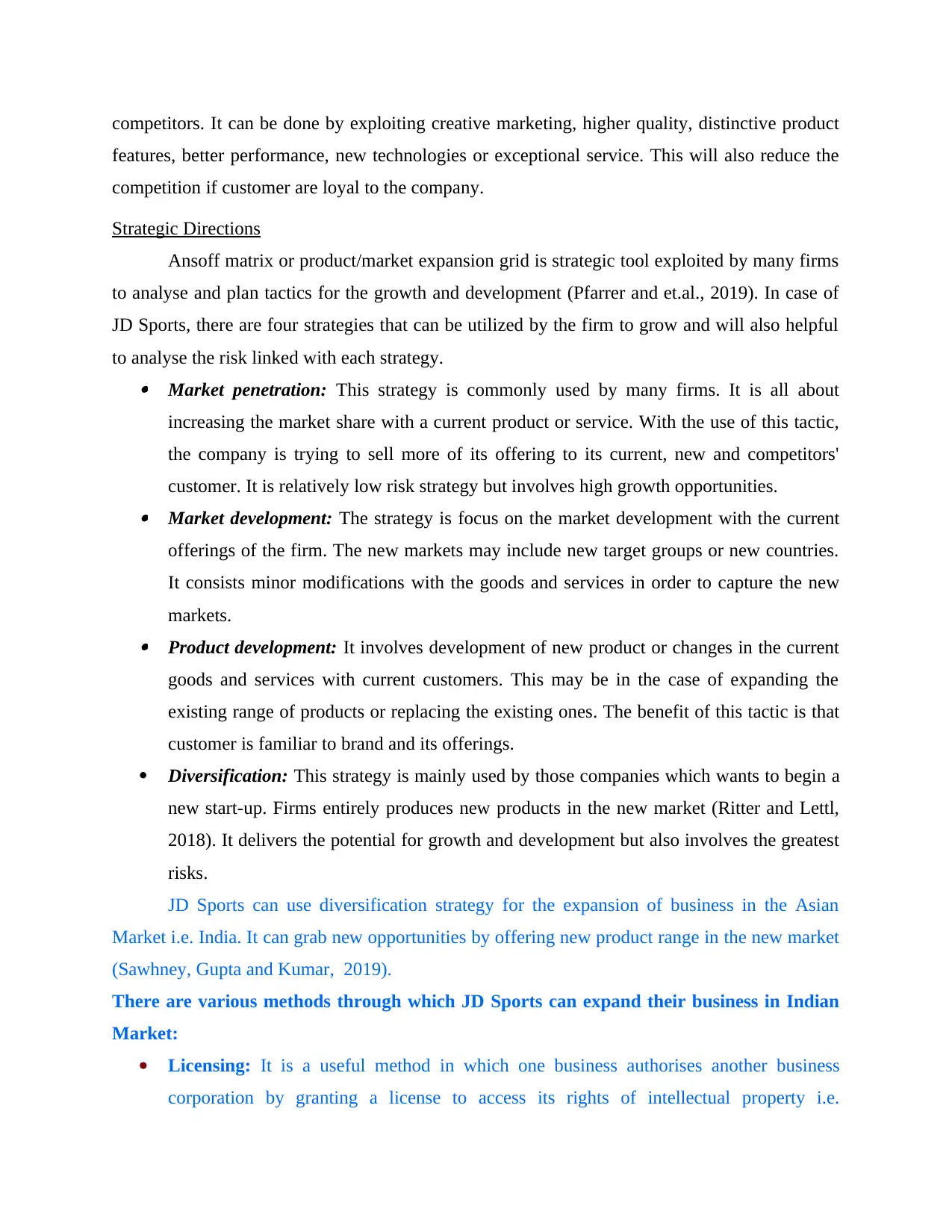
competitors. It can be done by exploiting creative marketing, higher quality, distinctive product
features, better performance, new technologies or exceptional service. This will also reduce the
competition if customer are loyal to the company.
Strategic Directions
Ansoff matrix or product/market expansion grid is strategic tool exploited by many firms
to analyse and plan tactics for the growth and development (Pfarrer and et.al., 2019). In case of
JD Sports, there are four strategies that can be utilized by the firm to grow and will also helpful
to analyse the risk linked with each strategy. Market penetration: This strategy is commonly used by many firms. It is all about
increasing the market share with a current product or service. With the use of this tactic,
the company is trying to sell more of its offering to its current, new and competitors'
customer. It is relatively low risk strategy but involves high growth opportunities. Market development: The strategy is focus on the market development with the current
offerings of the firm. The new markets may include new target groups or new countries.
It consists minor modifications with the goods and services in order to capture the new
markets. Product development: It involves development of new product or changes in the current
goods and services with current customers. This may be in the case of expanding the
existing range of products or replacing the existing ones. The benefit of this tactic is that
customer is familiar to brand and its offerings.
Diversification: This strategy is mainly used by those companies which wants to begin a
new start-up. Firms entirely produces new products in the new market (Ritter and Lettl,
2018). It delivers the potential for growth and development but also involves the greatest
risks.
JD Sports can use diversification strategy for the expansion of business in the Asian
Market i.e. India. It can grab new opportunities by offering new product range in the new market
(Sawhney, Gupta and Kumar, 2019).
There are various methods through which JD Sports can expand their business in Indian
Market:
Licensing: It is a useful method in which one business authorises another business
corporation by granting a license to access its rights of intellectual property i.e.
features, better performance, new technologies or exceptional service. This will also reduce the
competition if customer are loyal to the company.
Strategic Directions
Ansoff matrix or product/market expansion grid is strategic tool exploited by many firms
to analyse and plan tactics for the growth and development (Pfarrer and et.al., 2019). In case of
JD Sports, there are four strategies that can be utilized by the firm to grow and will also helpful
to analyse the risk linked with each strategy. Market penetration: This strategy is commonly used by many firms. It is all about
increasing the market share with a current product or service. With the use of this tactic,
the company is trying to sell more of its offering to its current, new and competitors'
customer. It is relatively low risk strategy but involves high growth opportunities. Market development: The strategy is focus on the market development with the current
offerings of the firm. The new markets may include new target groups or new countries.
It consists minor modifications with the goods and services in order to capture the new
markets. Product development: It involves development of new product or changes in the current
goods and services with current customers. This may be in the case of expanding the
existing range of products or replacing the existing ones. The benefit of this tactic is that
customer is familiar to brand and its offerings.
Diversification: This strategy is mainly used by those companies which wants to begin a
new start-up. Firms entirely produces new products in the new market (Ritter and Lettl,
2018). It delivers the potential for growth and development but also involves the greatest
risks.
JD Sports can use diversification strategy for the expansion of business in the Asian
Market i.e. India. It can grab new opportunities by offering new product range in the new market
(Sawhney, Gupta and Kumar, 2019).
There are various methods through which JD Sports can expand their business in Indian
Market:
Licensing: It is a useful method in which one business authorises another business
corporation by granting a license to access its rights of intellectual property i.e.
Paraphrase This Document
Need a fresh take? Get an instant paraphrase of this document with our AI Paraphraser
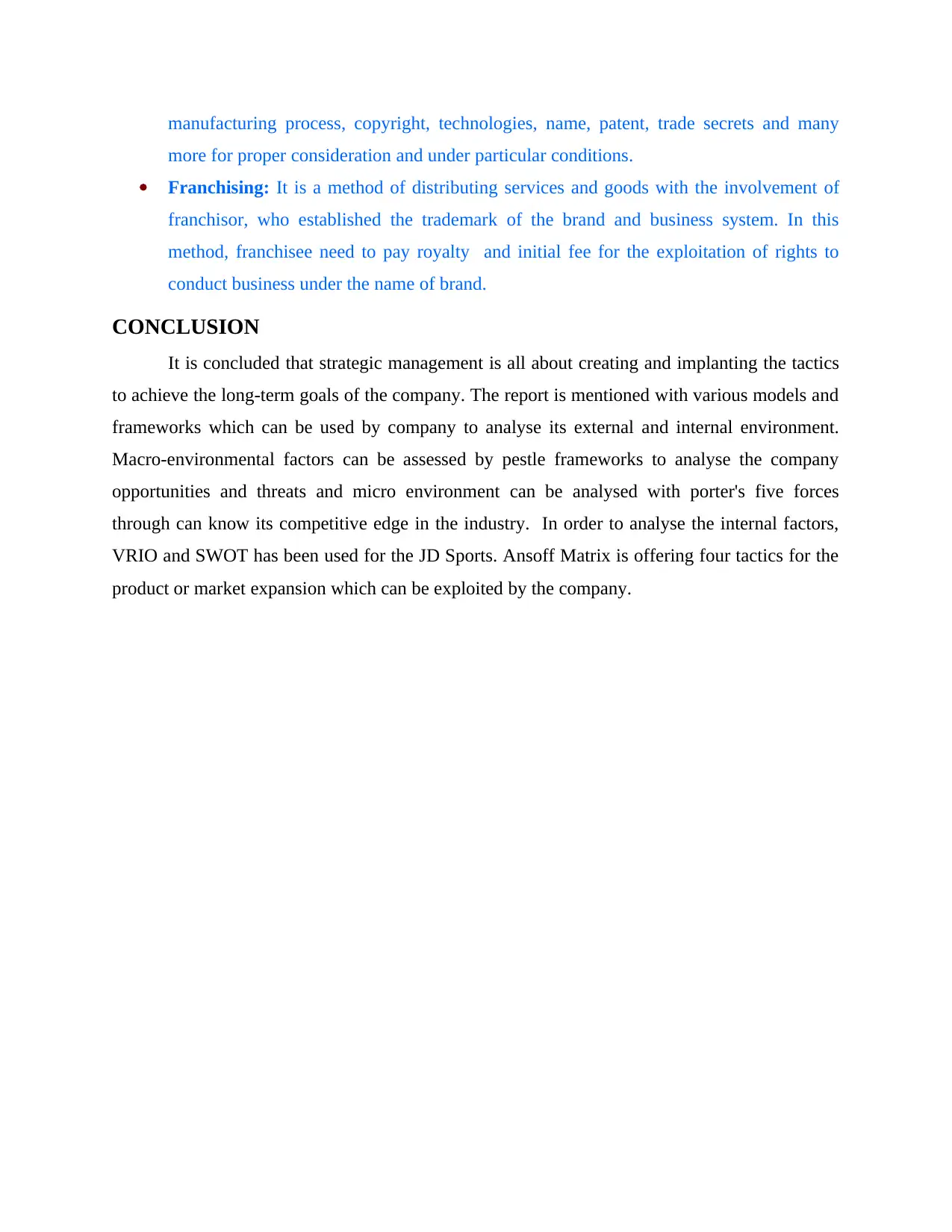
manufacturing process, copyright, technologies, name, patent, trade secrets and many
more for proper consideration and under particular conditions.
Franchising: It is a method of distributing services and goods with the involvement of
franchisor, who established the trademark of the brand and business system. In this
method, franchisee need to pay royalty and initial fee for the exploitation of rights to
conduct business under the name of brand.
CONCLUSION
It is concluded that strategic management is all about creating and implanting the tactics
to achieve the long-term goals of the company. The report is mentioned with various models and
frameworks which can be used by company to analyse its external and internal environment.
Macro-environmental factors can be assessed by pestle frameworks to analyse the company
opportunities and threats and micro environment can be analysed with porter's five forces
through can know its competitive edge in the industry. In order to analyse the internal factors,
VRIO and SWOT has been used for the JD Sports. Ansoff Matrix is offering four tactics for the
product or market expansion which can be exploited by the company.
more for proper consideration and under particular conditions.
Franchising: It is a method of distributing services and goods with the involvement of
franchisor, who established the trademark of the brand and business system. In this
method, franchisee need to pay royalty and initial fee for the exploitation of rights to
conduct business under the name of brand.
CONCLUSION
It is concluded that strategic management is all about creating and implanting the tactics
to achieve the long-term goals of the company. The report is mentioned with various models and
frameworks which can be used by company to analyse its external and internal environment.
Macro-environmental factors can be assessed by pestle frameworks to analyse the company
opportunities and threats and micro environment can be analysed with porter's five forces
through can know its competitive edge in the industry. In order to analyse the internal factors,
VRIO and SWOT has been used for the JD Sports. Ansoff Matrix is offering four tactics for the
product or market expansion which can be exploited by the company.
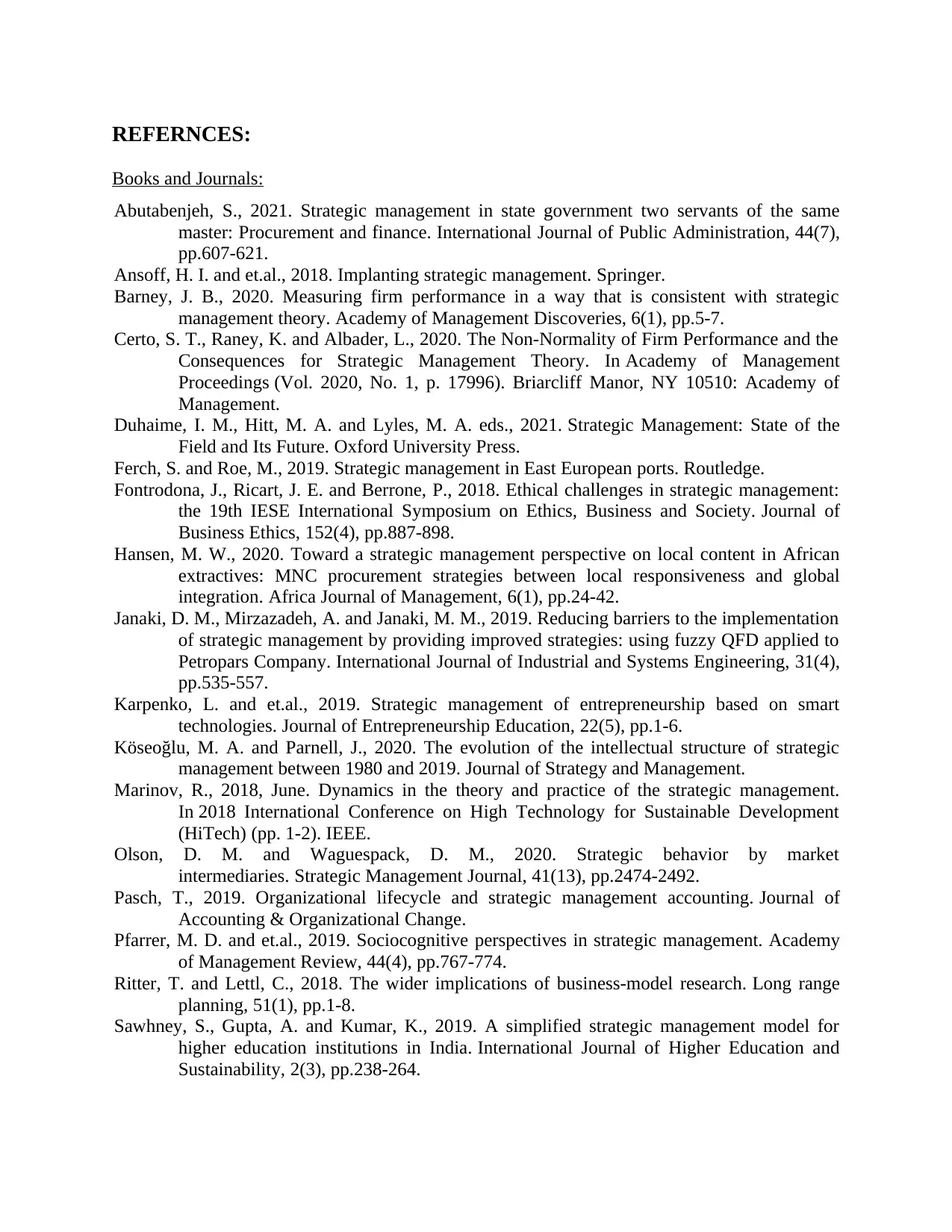
REFERNCES:
Books and Journals:
Abutabenjeh, S., 2021. Strategic management in state government two servants of the same
master: Procurement and finance. International Journal of Public Administration, 44(7),
pp.607-621.
Ansoff, H. I. and et.al., 2018. Implanting strategic management. Springer.
Barney, J. B., 2020. Measuring firm performance in a way that is consistent with strategic
management theory. Academy of Management Discoveries, 6(1), pp.5-7.
Certo, S. T., Raney, K. and Albader, L., 2020. The Non-Normality of Firm Performance and the
Consequences for Strategic Management Theory. In Academy of Management
Proceedings (Vol. 2020, No. 1, p. 17996). Briarcliff Manor, NY 10510: Academy of
Management.
Duhaime, I. M., Hitt, M. A. and Lyles, M. A. eds., 2021. Strategic Management: State of the
Field and Its Future. Oxford University Press.
Ferch, S. and Roe, M., 2019. Strategic management in East European ports. Routledge.
Fontrodona, J., Ricart, J. E. and Berrone, P., 2018. Ethical challenges in strategic management:
the 19th IESE International Symposium on Ethics, Business and Society. Journal of
Business Ethics, 152(4), pp.887-898.
Hansen, M. W., 2020. Toward a strategic management perspective on local content in African
extractives: MNC procurement strategies between local responsiveness and global
integration. Africa Journal of Management, 6(1), pp.24-42.
Janaki, D. M., Mirzazadeh, A. and Janaki, M. M., 2019. Reducing barriers to the implementation
of strategic management by providing improved strategies: using fuzzy QFD applied to
Petropars Company. International Journal of Industrial and Systems Engineering, 31(4),
pp.535-557.
Karpenko, L. and et.al., 2019. Strategic management of entrepreneurship based on smart
technologies. Journal of Entrepreneurship Education, 22(5), pp.1-6.
Köseoğlu, M. A. and Parnell, J., 2020. The evolution of the intellectual structure of strategic
management between 1980 and 2019. Journal of Strategy and Management.
Marinov, R., 2018, June. Dynamics in the theory and practice of the strategic management.
In 2018 International Conference on High Technology for Sustainable Development
(HiTech) (pp. 1-2). IEEE.
Olson, D. M. and Waguespack, D. M., 2020. Strategic behavior by market
intermediaries. Strategic Management Journal, 41(13), pp.2474-2492.
Pasch, T., 2019. Organizational lifecycle and strategic management accounting. Journal of
Accounting & Organizational Change.
Pfarrer, M. D. and et.al., 2019. Sociocognitive perspectives in strategic management. Academy
of Management Review, 44(4), pp.767-774.
Ritter, T. and Lettl, C., 2018. The wider implications of business-model research. Long range
planning, 51(1), pp.1-8.
Sawhney, S., Gupta, A. and Kumar, K., 2019. A simplified strategic management model for
higher education institutions in India. International Journal of Higher Education and
Sustainability, 2(3), pp.238-264.
Books and Journals:
Abutabenjeh, S., 2021. Strategic management in state government two servants of the same
master: Procurement and finance. International Journal of Public Administration, 44(7),
pp.607-621.
Ansoff, H. I. and et.al., 2018. Implanting strategic management. Springer.
Barney, J. B., 2020. Measuring firm performance in a way that is consistent with strategic
management theory. Academy of Management Discoveries, 6(1), pp.5-7.
Certo, S. T., Raney, K. and Albader, L., 2020. The Non-Normality of Firm Performance and the
Consequences for Strategic Management Theory. In Academy of Management
Proceedings (Vol. 2020, No. 1, p. 17996). Briarcliff Manor, NY 10510: Academy of
Management.
Duhaime, I. M., Hitt, M. A. and Lyles, M. A. eds., 2021. Strategic Management: State of the
Field and Its Future. Oxford University Press.
Ferch, S. and Roe, M., 2019. Strategic management in East European ports. Routledge.
Fontrodona, J., Ricart, J. E. and Berrone, P., 2018. Ethical challenges in strategic management:
the 19th IESE International Symposium on Ethics, Business and Society. Journal of
Business Ethics, 152(4), pp.887-898.
Hansen, M. W., 2020. Toward a strategic management perspective on local content in African
extractives: MNC procurement strategies between local responsiveness and global
integration. Africa Journal of Management, 6(1), pp.24-42.
Janaki, D. M., Mirzazadeh, A. and Janaki, M. M., 2019. Reducing barriers to the implementation
of strategic management by providing improved strategies: using fuzzy QFD applied to
Petropars Company. International Journal of Industrial and Systems Engineering, 31(4),
pp.535-557.
Karpenko, L. and et.al., 2019. Strategic management of entrepreneurship based on smart
technologies. Journal of Entrepreneurship Education, 22(5), pp.1-6.
Köseoğlu, M. A. and Parnell, J., 2020. The evolution of the intellectual structure of strategic
management between 1980 and 2019. Journal of Strategy and Management.
Marinov, R., 2018, June. Dynamics in the theory and practice of the strategic management.
In 2018 International Conference on High Technology for Sustainable Development
(HiTech) (pp. 1-2). IEEE.
Olson, D. M. and Waguespack, D. M., 2020. Strategic behavior by market
intermediaries. Strategic Management Journal, 41(13), pp.2474-2492.
Pasch, T., 2019. Organizational lifecycle and strategic management accounting. Journal of
Accounting & Organizational Change.
Pfarrer, M. D. and et.al., 2019. Sociocognitive perspectives in strategic management. Academy
of Management Review, 44(4), pp.767-774.
Ritter, T. and Lettl, C., 2018. The wider implications of business-model research. Long range
planning, 51(1), pp.1-8.
Sawhney, S., Gupta, A. and Kumar, K., 2019. A simplified strategic management model for
higher education institutions in India. International Journal of Higher Education and
Sustainability, 2(3), pp.238-264.
1 out of 15
Related Documents
Your All-in-One AI-Powered Toolkit for Academic Success.
+13062052269
info@desklib.com
Available 24*7 on WhatsApp / Email
![[object Object]](/_next/static/media/star-bottom.7253800d.svg)
Unlock your academic potential
© 2024 | Zucol Services PVT LTD | All rights reserved.




